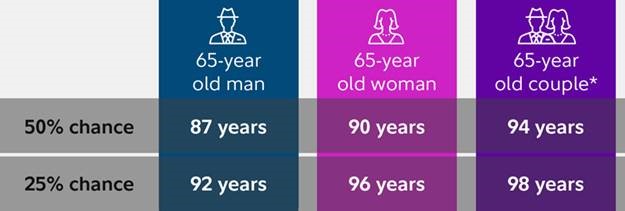Common Misconceptions About Investing Time Horizon
Submitted by Silverlight Asset Management, LLC on May 2nd, 2018
“Let’s talk about time. I’m not sure how much I’ve got left, ok? I’m 70. Longevity does not run in my family. So, how much should a guy like me have in the stock market?”
That’s what a client asked during a recent meeting. Great question.
Time horizon is an important subject that repeatedly surfaces in my interactions with investors. Several issues from this meeting may help other investors think more clearly about their own time horizon.
Time horizon is not always linked to age
Conventional thinking is the older you are the less investing risk you should assume. That’s true in some cases, but not all. A better proxy for gauging time horizon is the longevity of the assets.
Start by asking: What’s the money for?
For example, a 45-year old with a kid getting ready to go to college probably has a short time horizon for a portion of their money.
My client, on the other hand, actually has a long time horizon, despite being 70. We arrived at that determination by following the money trail.
Unless you plan to have your financial accounts liquidated upon your demise, and the cash stuffed alongside you wherever your final resting place happens to be, the money lives on. This became apparent when I asked my client what happens to the money after he passes. In his case, his wife maintains it. She’s younger, and her family’s genes are biased to longer longevity. Maybe she lives another 20-30 years?
Most people underestimate how long they’ll live. That’s because each generation is hanging around a little longer than previous generations.
According to Laura Carstensen, director of the Stanford Center on Longevity, life expectancy increases about 3 months with each year that passes. Today, there is a 50% chance at least one half of a 65-year old couple will live to the age of 94. Pretty amazing, considering the average life expectancy in 1900 was 47 years!

Source: Fidelity
It doesn’t stop there though. After my clients both eventually pass, their money transfers to children. That makes the next generation the time horizon proxy.
So while my client presumed his time horizon may be short given his age, in reality, it could be 50 or more years. That means plenty of market cycles and a lot of flexibility in terms of asset allocation choices.
Tip: A long time horizon is a significant investing advantage. Make sure you don’t short change yours.
Covering health care costs
Even though my clients comfortably fund their current living expenses, they worry about health care costs. What if they rise enough to strain their budget?
After housing, health care is likely to be most peoples’ second largest expense during retirement. According to Fidelity Benefits Consulting, a 65-year old couple retiring this year probably needs close to $280,000 in today’s dollars (after-tax) to full cover estimated medical expenses in retirement.
Big number. And a big deal, considering approximately 40% of pre-retirees are not currently factoring health care costs into their retirement savings plans.
Yes, Medicare begins at age 65. But it’s not likely cover everything! The average retiree should expect to pay around $5,000 per year in extra costs for supplemental insurance and out of pocket expenses. Health care utilization increases with age, so it’s important to factor this expense into your planning.
Tip: If you’re still working, you can get ahead of the curve on these costs by contributing to an HSA (Health Savings Account). These plans allow you to stash away more pretax dollars which you can grow and withdraw tax free, for federal tax purposes, if you use the funds for qualified medical expenses.
Finding the right volatility profile
Since my clients are in good shape to fund their financial goals, there’s no need to press for higher returns beyond their comfort threshold. Some call this: “The Sleep-at-Night-Factor.” Independent of time horizon, comfort matters, because even the best strategy in the world is worthless if somebody can’t stomach the ride and stick with it.
My clients monitor relative performance. But we’ve had enough discussions to clearly delineate that their objectives revolve around absolute risk/return parameters.
Thus, even though I could be comfortable allocating this client's portfolio 100% to equities, we know that’s not the right allocation. They aren’t just trying to maximize returns relative to how long they have to invest. There are psychological constraints to consider.
The way to configure asset allocation strategy in this type of scenario is to identify a maximum volatility threshold, which I call a “Risk Budget.” This could take the form of an annualized volatility target or max drawdown threshold relating to stress test scenarios.
People work hard for their money. They justifiably want it to work hard for them. So stuffing money under mattresses usually isn’t the answer.
Tip: Once a risk budget is delineated, you can make the goal maximizing returns within a customized risk boundary. That’s ultimately how my clients and I arrived at the ideal asset allocation for them. Time horizon actually had little to do with the proportion of stocks versus bonds.
***
In conclusion, try to resist generic formulas or heuristic shortcuts when it comes to time horizon. Some number minus your age will not tell you the best stock allocation for your portfolio. Investing is a highly individualized sport. There are many nuances to consider.
Also published by RealClearMarkets. Reprinted with permission.
Disclosure: This material is not intended to be relied upon as a forecast, research or investment advice, and is not a recommendation, offer or solicitation to buy or sell any securities or to adopt any investment strategy. The opinions expressed are as of the date indicated and may change as subsequent conditions vary. The information and opinions contained in this post are derived from proprietary and nonproprietary sources deemed by Silverlight Asset Management LLC to be reliable, are not necessarily all-inclusive and are not guaranteed as to accuracy. As such, no warranty of accuracy or reliability is given and no responsibility arising in any other way for errors and omissions (including responsibility to any person by reason of negligence) is accepted by Silverlight Asset Management LLC, its officers, employees or agents. This post may contain “forward-looking” information that is not purely historical in nature. Such information may include, among other things, projections and forecasts. There is no guarantee that any of these views will come to pass. Reliance upon information in this post is at the sole discretion of the reader.
Testimonials Content Block
More Than an Investment Manager—A Trusted Guide to Financial Growth
"I’ve had the great pleasure of having Michael as my investment manager for the past several years. In fact, he is way more than that. He is a trusted guide who coaches his clients to look first at life’s bigger picture and then align their financial decisions to support where they want to go. Michael and his firm take a unique and personal coaching approach that has really resonated for me and helped me to reflect upon my core values and aspirations throughout my investment journey.
Michael’s focus on guiding the "why" behind my financial decisions has been invaluable to me in helping to create a meaningful strategy that has supported both my short-term goals and my long-term dreams. He listens deeply, responds thoughtfully, and engages in a way that has made my investment decisions intentional and personally empowering. With Michael, it’s not just about numbers—it’s about crafting a story of financial growth that has truly supports the life I want to live."
-Karen W.
Beyond financial guidance!
"As a long-term client of Silverlight, I’ve experienced not only market-beating returns but also invaluable coaching and support. Their guidance goes beyond finances—helping me grow, make smarter decisions, and build a life I truly love. Silverlight isn’t just about wealth management; they’re invested in helping me secure my success & future legacy!"
-Chris B.
All You Need Know to Win
“You likely can’t run a four-minute mile but Michael’s new book parses all you need know to win the workaday retirement race. Readable, authoritative, and thorough, you’ll want to spend a lot more than four minutes with it.”
-Ken Fisher
Founder, Executive Chairman and Co-CIO, Fisher Investments
New York Times Bestselling Author and Global Columnist.
Packed with Investment Wisdom
“The sooner you embark on The Four-Minute Retirement Plan, the sooner you’ll start heading in the right direction. This fun, practical, and thoughtful book is packed with investment wisdom; investors of all ages should read it now.”
-Joel Greenblatt
Managing Principal, Gotham Asset Management;
New York Times bestselling author, The Little Book That Beats the Market
Great Full Cycle Investing
“In order to preserve and protect your pile of hard-earned capital, you need to be coached by pros like Michael. He has both the experience and performance in The Game to prove it. This is a great Full Cycle Investing #process book!”
-Keith McCullough
Chief Executive Officer, Hedgeye Risk Management
Author, Diary of a Hedge Fund Manager
Clear Guidance...Essential Reading
“The Four-Minute Retirement Plan masterfully distills the wisdom and experience Michael acquired through years of highly successful wealth management into a concise and actionable plan that can be implemented by everyone. With its clear guidance, hands-on approach, and empowering message, this book is essential reading for anyone who wants to take control of their finances and secure a prosperous future.”
-Vincent Deluard
Director of Global Macro Strategy, StoneX

